Sports Lighting Glare
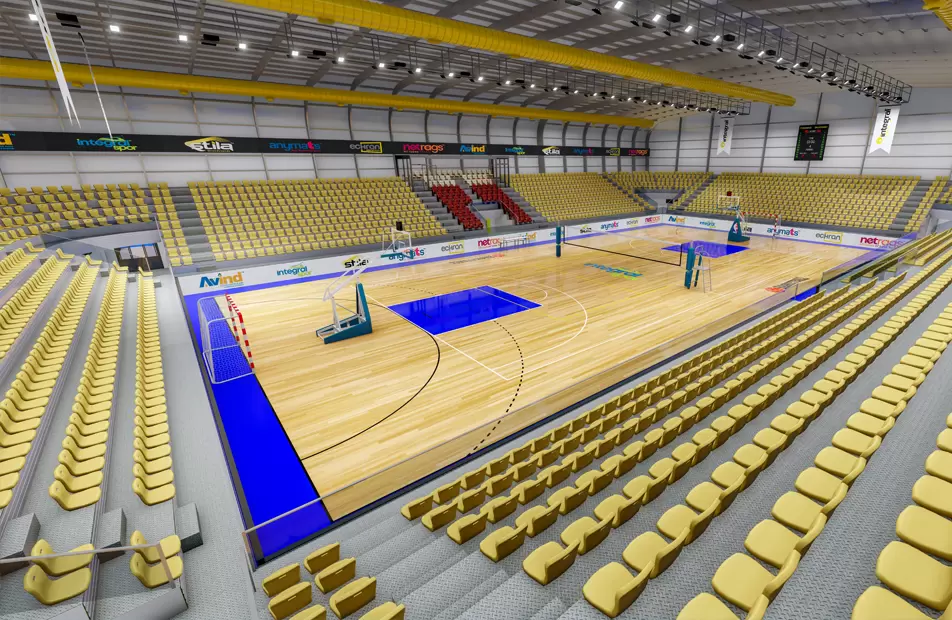
Directory:
1. Basic Understanding of Glare
2. Glare Control Standards and Evaluation Methods
3. Basketball Hall Simulation Design
In recent years, the emergence of green lighting has led to the introduction of more eco-friendly and energy-efficient lamps, which are gradually replacing traditional lighting sources. Concurrently, as more people engage in sports, the lighting conditions in sports venues have garnered increased attention. To create a comfortable lighting environment for both athletes and spectators, managing glare from lighting fixtures in these venues is crucial. Historically, the sports lighting design focused solely on environmental illumination, which is inadequate for sports lighting. Effective sports lighting must address not only illumination but also the glare produced by high-brightness lamps. Finding ways to minimize glare while ensuring uniform lighting that meets illumination standards is a significant area of research.
Given the variety of glare algorithms, each suited to different sports venues, this article uses the lighting of a basketball hall as a case study to explore the sources of glare. The impact of glare can be mitigated by managing non-light source factors, primarily through the strategic arrangement of lamps, adjusting lamp power, selecting an appropriate ambient brightness ratio, and using materials with low reflectivity. By examining the relevant glare values, a glare calculation method tailored for indoor sports venues is developed. Subsequently, software simulations of indoor lighting are conducted, incorporating glare observation points to determine the maximum glare value within the venue.
1. Basic Understanding of Glare
1.1 Dangers of Glare
Glare results from an uneven distribution of light brightness within the field of vision. A significant contrast between the brightness of a light source and the surrounding environment can also lead to glare, particularly when looking directly at a high-intensity light source.
Glare primarily affects the eyes and can transmit discomfort to the nervous system. It can severely impair visual function, and prolonged exposure can lead to eye fatigue. For drivers, glare can distract their focus, potentially leading to dangerous situations. Working in a glare-filled environment can cause discomfort; mild cases may result in irritability, while severe cases can slow reaction times and diminish work efficiency. In sports venues, it is essential to balance high brightness with ambient light levels to prevent glare from harming athletes and spectators.
1.2 Glare Prevention
To manage the brightness of lamps and the light entering the human eye, three primary methods are typically employed:
(1) Lower the power of lamps to avoid excessive brightness while still fulfilling lighting needs;
(2) Position lamps appropriately to ensure they are shielded from direct light entering the eyes;
(3) Adjust the surface brightness and reflection intensity of lamps to enhance the background brightness of the light source, thereby minimizing the overall contrast in environmental brightness.
Reflected glare refers to the disruption caused by high-brightness light sources bouncing off shiny materials or surfaces, affecting the human eye or camera lenses. For instance, reflections from computer screens or glass exteriors can create significant glare. Prolonged exposure to such glare can lead to discomfort and irritability.
In both indoor and outdoor sports venues, it is essential to balance the relationship between light sources, reflective materials, and human viewpoints. When selecting materials, those with high reflectivity should be avoided. Additionally, glare can be mitigated by increasing the brightness from above using semi-direct or semi-indirect lighting, which helps distribute light evenly throughout the space. By implementing these strategies, a balanced ambient brightness can be achieved, effectively reducing glare.
1.3 Design of Anti-Glare Lamps
Glare primarily results from direct exposure to unshielded light sources. To mitigate this, light sources are enclosed within a lamp, often featuring a lampshade. The lampshade is crucial in reducing glare; without it, the unshielded light can directly impact the eyes, making reading difficult. By incorporating a lampshade, the upward light from the desk lamp is restricted, allowing illumination to focus on the intended work area.
Anti-glare grille lights are designed to minimize glare through the use of grilles that effectively control the light's angle, preventing direct sight of the exposed light source. Typically, these grille lights are installed in ceilings, with reflectors positioned above them. This setup utilizes reflection and refraction to create a broader lighting area, ensuring a more uniform light distribution and significantly reducing the presence of intense light spots, thereby lessening glare.
1.4 Optimal Ambient Brightness Ratio
Prolonged exposure to high-brightness environments can diminish the perceived glare effect, even from bright light sources. For instance, while it is uncomfortable to look directly at car headlights at night, doing so during the day is generally tolerable. This indicates that effective design should aim for uniform brightness distribution within a space, avoiding significant variations in ambient brightness. By lowering the ambient brightness ratio, the adverse effects of glare can be minimized.
2. Glare Control Standards and Evaluation Methods
2.1 Glare Control Standards
Glare control standards vary by location, leading to different requirements for acceptable glare levels in various venues. This article focuses on the specific context of indoor basketball arenas and aims to establish appropriate glare limits. Table 1 presents the maximum glare values recommended by the International Commission on Illumination (CIE) for different environments, which should not be exceeded in lighting design.
Tab.1 CIE glare control standards

2.2 Lighting Techniques for Sports Facilities
There are various lighting techniques used in sports facilities:
(1) Lights are positioned evenly above the area. The downside of this setup is that it provides low illumination, making it suitable for general training spaces;
(2) Lights are placed both above and along the sides of the area, allowing for consideration of both horizontal and vertical illumination. This configuration is more commonly used;
(3) Lights are installed above the venue, which is ideal for spaces with higher ceilings. This method offers the best control of glare.
Sports lighting encompasses more than just these techniques. Different sports require specific lighting solutions, and each venue has its own distinct lighting approach. The methods mentioned above are primarily utilized in indoor and outdoor basketball courts.
2.3 Fundamental glare assessment technique
2.3.1 Glare Index (GR) Approach
The formula used to calculate the lighting glare index is
![]()
In this context, L represents the brightness produced by the light from the lamp that directly reaches the eyes, while Le denotes the brightness from the illuminated area that directly impacts the eyes. By eliminating constants and unnecessary terms, the formula can be simplified to
![]()
Substitute Lvi with "brightness generated by the lamp" and Lve with "brightness of the illuminated site," since the site does not produce its own brightness but rather receives it from the lamp's illumination. Therefore, it can be concluded that
![]()
GR takes into account the background of the illuminated area, specifically the work surface, while disregarding other reflected light sources like wall billboards.
3. Basketball Hall Simulation Design
3.1 Model Creation
To begin, create a model of the indoor basketball hall. Utilize the point method to draft the floor plan of the indoor court and adjust the dimensions for a venue designed to accommodate three courts. The standard dimensions are 40 meters in length, 65 meters in width, and 12 meters in height.
3.2 Lighting Design
The lighting design is carried out using DIALux software.
3.3 Lighting Setup for a Single Court
Initially, set up the lighting in two rows for one court. Modify the number of lights in each row to achieve illumination levels close to the standard requirements, and then add lights at specific points to enhance lighting in areas that are lacking. Next, arrange the lighting for the individual court, adjusting the height and angle to fulfill the illumination criteria. Given the symmetry of the court and the fact that players look up while shooting, the lights should be positioned directly downward rather than at an angle. As illustrated in Figure 2. the pseudo-color display and contour line analysis indicate that the illumination in the center of the court is consistent, meeting the 300 lux standard for basketball hall lighting, while the wall illumination reaches 150 lux, ensuring a relatively uniform environment that helps minimize glare.
Fig.2 380W lighting pseudo color diagram of individual stadium lighting
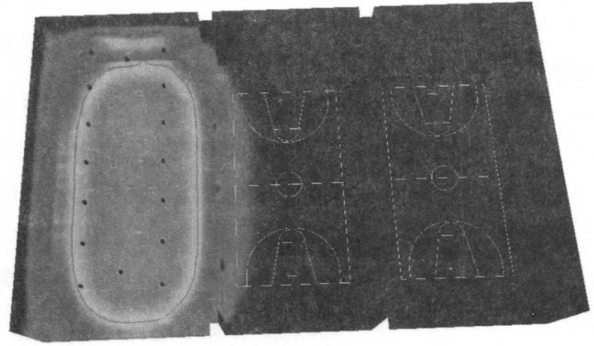
3.4 Arrangement of GR Observation Points
Once the lighting conditions are satisfactory, GR observation points should be established to assess the glare levels. The exact locations for the GR points are illustrated in Figure 3. The six points depicted are designated as GR observation points, and they are positioned at a height of 1.5 meters, which aligns with the average height of the human eye.
Fig.3 Layout of GR observation points
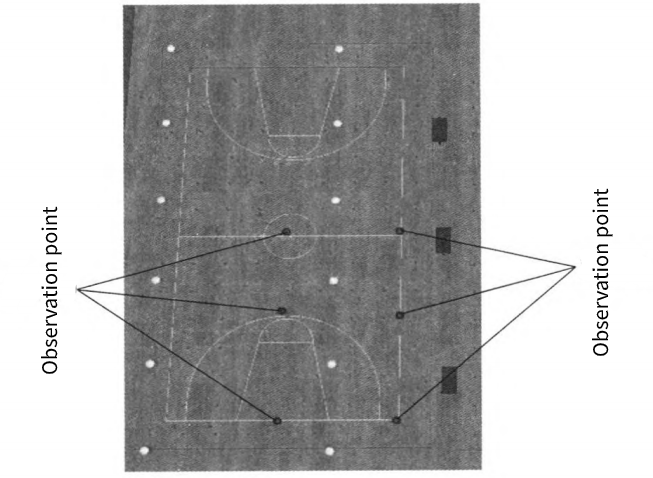
Once the GR observation points are set up, software is used to calculate the GR value for each point. These values are then compared to the CIE standard values to assess if the designed court meets the CIE criteria. The recorded GR values are presented in Table 2.
Tab.2 Calculation of GR values
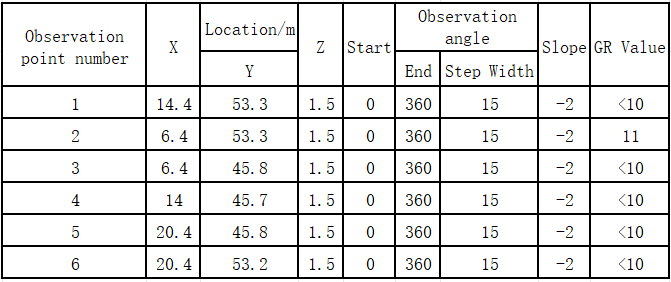
Table 2 indicates that the highest glare value for the design is 11. which fully complies with the stadium's design standards. Next, the lamps will be arranged in the three stadiums, and the glare rating (GR) and illumination levels will be calculated.
3.5 Overall Stadium Design
The lamps will be positioned one above the other in the two additional stadiums. As shown in Figure 4. 18 points for GR calculations will be established. By creating isolines (refer to Figure 5), it is evident that all three stadium areas maintain an illumination level of 300 lx, while the overall stadium illumination exceeds 2001 lx. Analyzing the pseudo-color image in Figure 6 reveals that there are no significant variations in illumination across the stadium. The floor illumination is above 200 lx, and the wall illumination is above 1001 lx. This setup helps to reduce environmental contrast and lower the glare value.
Fig.4 GR layout in the stadium
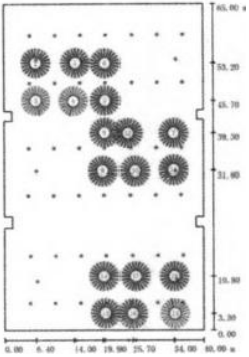
According to the data presented in Table 3. the highest GR value recorded in the stadium is 11. which satisfies the glare control standards for lighting design.
Figure 5 displays a contour map where the thin line indicates the 300 lx illumination boundary. The stadium is primarily located within this 300 lx contour. The illumination levels at the edges exceed 250 lx, and there are no significant variations in illumination across the area.
Fig.5 Contou map
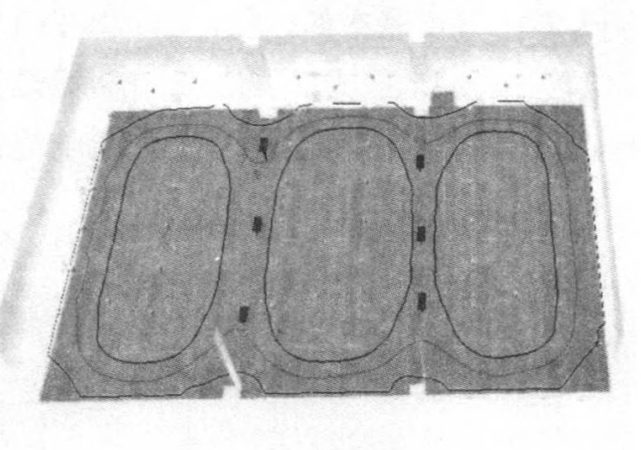
Fig.6 Pseudo color chart of the stadium
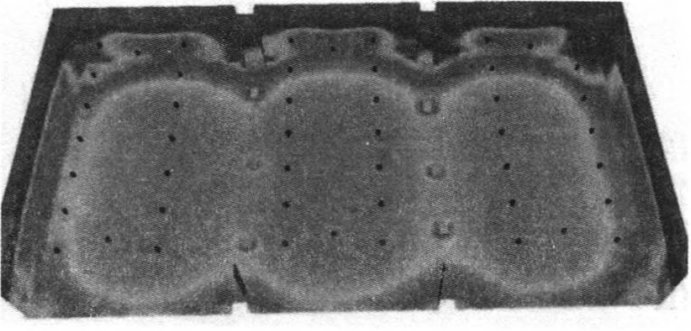
Tab.3 GR points for the whole stadium
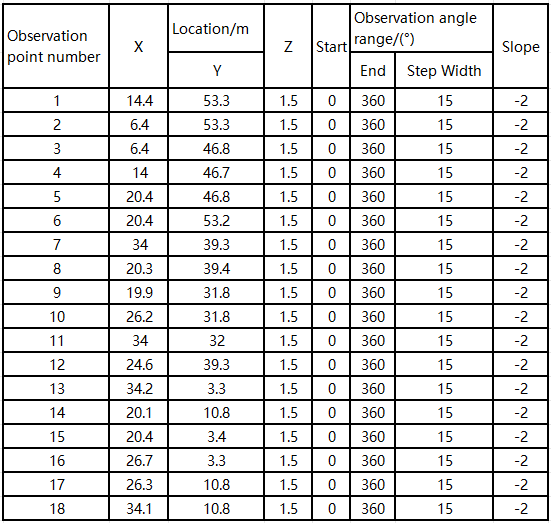
Figure 7 displays the point illumination map for the entire stadium, which allows for the assessment of illumination levels in each area. All sections of the stadium meet the required standard of approximately 300 lx, with no significant variations noted.
Figure 8 presents the iso-illuminance map of the ceiling, where the illumination is maintained above 1001 lx. This helps to minimize the contrast between the background brightness and the ambient light, effectively reducing glare by managing the ratio of ambient brightness. The ceiling serves as the backdrop for the lighting; if it is too dim, it can cause glare when individuals look up. Maintaining a certain level of brightness on the ceiling ensures that the difference between it and the light source is not excessive, significantly mitigating glare effects.
Fig.7 Point illuminance map
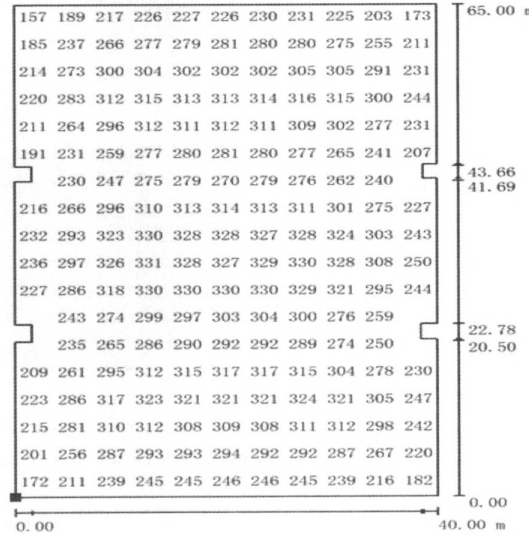
Fig.8 Ceiling illumination

The simulation design allows us to clearly identify the elements that contribute to glare. By managing these controllable factors in the design process, we can achieve lighting conditions that align with real-life needs. Key considerations in the design include lamp wattage, light distribution patterns, and material reflectivity. Additionally, it is important to ensure that the illumination is as uniform as possible while still meeting the necessary lighting standards. This paper uses an indoor basketball court as a case study to calculate the glare rating (GR) and develop an appropriate algorithm for this specific environment.
4. Related Product
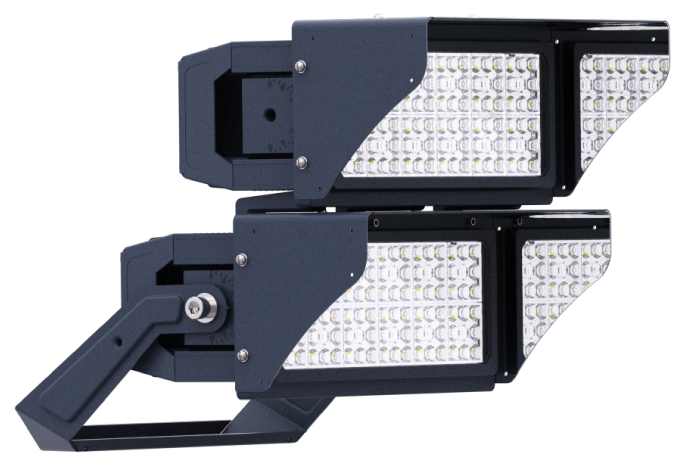
5. People Also Ask
What is the best lighting for no glare?
The best glare-free lighting combines optical design, smart positioning, and adaptive technologies: Mount fixtures at heights/angles ensuring a cutoff angle ≥ 45° to hide direct light sources from view.Use louvres, baffles, or recessed mounting to block high-angle glare... more
What is the glare rating for sports lighting?
Glare ratings for sports lighting are defined by indoor (UGR) and outdoor (GR) standards, with technical requirements as follows:Luminaire luminance ≤2.500 cd/m².Asymmetric optics (e.g., 110°×60° beam) with microprismatic diffusers.Background-to-source luminance ratio <1:5... more